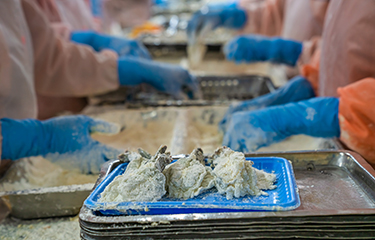Vietnam is sending more seafood products to Asian markets as demand in the U.S. and Europe has dropped amid high inflation.
Vietnam’s seafood exports to China have heated up in the run-up to Chinese New Year, and the Regional Comprehensive Economic Partnership has helped boost Vietnam’s shipments to Japan, according to the Vietnam Association of Seafood Exporters and Producers (VASEP).
In October, Vietnam exported a total of USD 907.4 million (EUR 871 million) worth of seafood, up 1.8 percent year-on-year and 5.2 percent from September, according to latest customs data.
Its sales to China reached USD 141 million (EUR 135.3 million), up 60.8 percent year-on-year, and its sales to Japan increased 32.4 percent year-over-year to hit USD 160.6 million (EUR 154.2 million). Its sales to Thailand also increased 35.8 percent year-over-year in the month to USD 29.4 million (EUR 28.2 million).
However, the value of its exports to non-Asia markets declined, with its U.S. sales down 31.7 percent year-over-year to USD 150.5 million (EUR 144 million), its sales to the U.K. dropped 10.2 percent to USD 29.4 million (EUR 28.2 million); and its Canadian sales were down 29.4 percent year-over-year to USD 22 million (EUR 21.1 million).
Vietnam’s shrimp sector typically records its best numbers of the year for exports in November and December but its producers have struggled to secure raw materials amid high inflation and Vietnam’s own mounting shrimp disease issues.
Vietnam’s October shrimp sales fell to USD 313 million (EUR 300.6 million), an eight-month low, and down 26 percent year-on-year. Its sales to Japan shrunk 19 percent year-on-year, its South Korean sales were down 26 percent, its U.S. sank 56 percent, and its E.U. sales dropped 55 percent year-on-year in October. However, its shrimp exports to China and Hong Kong increased 18 percent year-on-year and 14 percent year-on-year, respectively, in October.
China has taken in more shrimp from Vietnam recently to offset lower domestic production due to unfavorable weather conditions and an uptick in problems with disease. As a result, Vietnam, Ecuador, Indonesia, and Argentina have all recorded higher shrimp sales to China.
Rising production costs, and a tightening of capital stemming from efforts by the Vietnamese government to contain inflation, will make it harder for Vietnam’s shrimp industry to grow its production and processing activities in the coming months, VASEP said.
Following shrimp, pangasius is Vietnam’s second most-valuable seafood export, but Vietnam also saw a falloff of pangasius sales in October, hitting a 10-month low of USD 159 million (EUR 152.7 million) – down nearly 50 percent from the USD 310 million (EUR 297.7 million) in sales value recorded in April 2022.
Vietnam’s pangasius sales to the U.S., the E.U., and the U.K. all decreased, as did its sales to countries belonging to the Comprehensive and Progressive Agreement for Trans-Pacific Partnership (CPTPP), through which Vietnamese pangasius enjoys tax advantages, VASEP said.
Vietnam’s pangasius sales to the U.S. dropped nearly 25 percent year-on-year to USD 32 million (EUR 30.7 million) in October, continuing a decline that began in April, when Vietnam exported USD 81 million (EUR 77.8 million) worth of pangasius.
Vietnam’s October pangasius sales to the E.U. varied by country, with sales to Belgium contracting 25 percent year-on-year, but sales to Germany jumping 384 percent, Spanish sales up 142 percent, and Dutch sales up 10 percent. Vietnam’s sales to alternative markets, including Mexico, Malaysia, Colombia, Saudi Arabia, all decreased by between 13 percent and 53 percent in value in October.
But once again, Vietnam realized higher sales to China, with sales to mainland China up 23 percent and Hong Kong sales rising 123 percent year-on-year. Through the first 10 months of 2022, mainland China was the single largest market for Vietnamese pangasius, with a total export value of USD 594 million (EUR 570 million), up 106 percent over the same period in 2021. Overall, in the first 10 months of 2022, Vietnam’s pangasius export value had risen 75 percent year-on-year to USD 2.1 billion (EUR 2 billion) and VASEP has forecast sales will surpass USD 2.5 billion (EUR 2.4 billion) for 2022, up 54 percent from 2021.
Vietnam produced 1.357 million metric tons (MT) of pangasius between January and October, up 14.6 percent year-on-year, data from Vietnam’s Agriculture Ministry revealed. Pond prices of pangasius in October were between VND 29,000 and VND 30,500 (USD 1.17 and USD 1.23, EUR 1.12 and EUR 1.18) per kilogram, up from between VND 21,000 and VND 23,000 (USD 0.84 and USD 0.92, EUR 0.82 and EUR 0.89) per kilogram in the same month in 2021.
Despite the higher year-on-year prices, purchases of material pangasius from local processors were slowed due to weak global demand. Furthermore, adverse weather conditions and slack market demand, along with higher input costs, have combined to make pangasius farming more expensive, while prices have not adjusted to reflect the increases due to weak demand, squeezing local farmers.
In October, pangasius fingerling prices fell by between VND 3,000 and VND 5,000 (USD 0.12 and USD 0.20, EUR 0.11 and EUR 0.19) per kilogram to between VND 32,000 and VND 33,000 (USD 1.28 and USD 1.32, EUR 1.24 and EUR 1.28) per kilogram, the agriculture ministry said.
Photo courtesy of Nguyen Quang Ngoc Tonkin/Shutterstock







